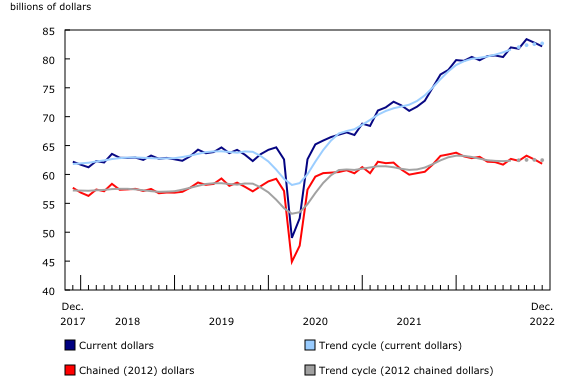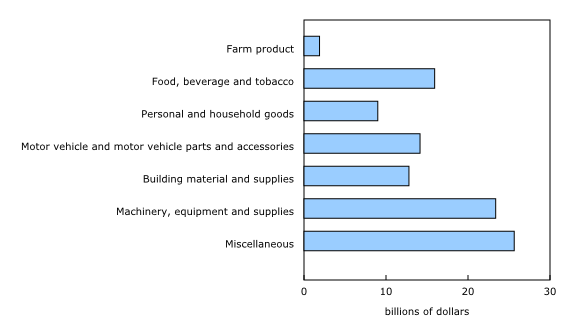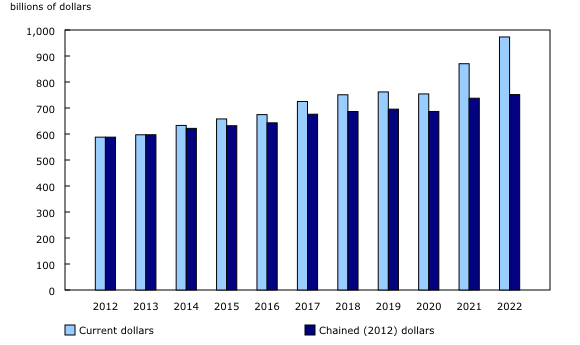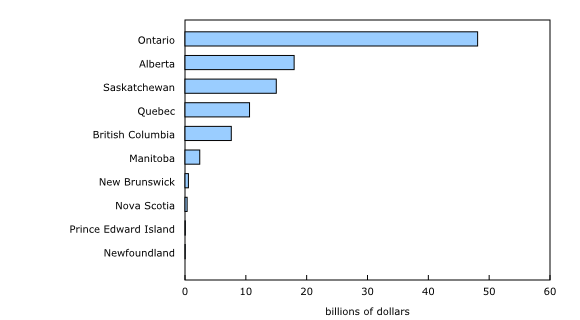Wholesale trade, December 2022
Released: 2023-02-15
$82.2 billion
December 2022
-0.8% 
(monthly change)
$355.8 million
December 2022
-12.5% 
(monthly change)
$115.5 million
December 2022
-0.7% 
(monthly change)
$1,031.6 million
December 2022
-8.0% 
(monthly change)
$790.1 million
December 2022
3.9% 
(monthly change)
$15,504.2 million
December 2022
0.2% 
(monthly change)
$42,137.2 million
December 2022
0.5% 
(monthly change)
$1,881.3 million
December 2022
-5.8% 
(monthly change)
$4,006.1 million
December 2022
4.3% 
(monthly change)
$9,039.3 million
December 2022
-1.1% 
(monthly change)
$7,255.0 million
December 2022
-8.6% 
(monthly change)
x
December 2022
x
(monthly change)
$32.1 million
December 2022
-21.2% 
(monthly change)
x
December 2022
x
(monthly change)
Wholesale sales decline in December
Wholesale sales fell 0.8% to $82.2 billion in December. Declines in the machinery, equipment and supplies subsector and the miscellaneous goods subsector led the losses. Sales fell in five of seven subsectors, which represented 68% of wholesale sales.
Constant dollar sales fell 1.2% in December.
Machinery, equipment and supplies posts its second-largest decline of the year
Sales in machinery, equipment and supplies fell 3.1% to $17.2 billion in December. Despite this decline, sales in the subsector were 8.6% higher than in December 2021. In December 2022, three of the four industry groups reported a rise in sales; however, the decline of the construction, forestry, mining, and industrial machinery, equipment and supplies industry group (-10.4% to $5.5 billion) offset the overall subsector growth. The monthly decline of this industry group was due to multiple project completions and deliveries in November. Excluding this decline, the subsector grew by 0.9%.
The miscellaneous subsector (-1.7% to $11.8 billion) reported a decrease of sales for the second consecutive month. There was a widespread decline of all five industry groups, the other miscellaneous (-3.2% to $2.8 billion) and recyclable material (-6.1% to $1.2 billion) industry groups leading the drop of sales.
An increase of sales in the food, beverage and tobacco subsector (+2.2% to $14.9 billion) partially offset the wholesale trade decline in December. All three industry groups reported an increase month over month, but the growth was mainly led by food (+2.1% to $13.3 billion). Grocery prices grew at a slower pace; however, price growth of fresh vegetables and other fresh vegetables accelerated, as reported in the most recent Consumer Price Index release.
British Columbia leads decline in sales
Sales decreased in six provinces in December. British Columbia reported the largest decline, followed by Manitoba and Alberta. Higher sales in Ontario and Saskatchewan dampened the decline in national sales.
In British Columbia, sales fell 8.6% to $7.3 billion in December, reaching their lowest level in the last 12 months. This was the largest monthly decline since the start of the COVID-19 pandemic. While sales were down in six of seven subsectors, 75% of the provincial decline came from the building material and supplies subsector and the machinery, equipment and supplies subsector. In December, sales in building material and supplies (-12.9% to $2.0 billion) reached their lowest level in the last 16 months, with most of the decrease coming from the lumber, millwork, hardware and other building supplies component industry. In the machinery, equipment and supplies subsector, sales dropped 14.4% to $1.3 billion, the largest monthly change on record. Almost half of the decline came from the construction, forestry, mining, and industrial machinery, equipment and supplies industry group. According to the Industrial Product Price Index, the price of softwood lumber was down 8.9% in December.
Sales in Manitoba dropped 5.8% to $1.9 billion in December, with lower sales in four of the seven subsectors. The machinery, equipment and supplies subsector (-12.3% to $384.4 million) and the miscellaneous goods subsector (-8.8% to $343.3 million) led the decrease in this province.
In Alberta, sales fell 1.1% to $9.0 billion in December. Similar to Manitoba, sales decreased in four of the seven subsectors. The decline was led by the machinery, equipment and supplies subsector (-2.4% to $2.9 billion) and the miscellaneous goods subsector (-4.8% to $1.3 billion).
Inventories back on the rise in December
Inventory levels rebounded in December, increasing 0.5% to $126.6 billion, after dropping in November, which was the first decrease since January 2022. Three of the seven subsectors reported higher inventories, led by the personal and household goods subsector and the building material and supplies subsector. Meanwhile, the remaining four subsectors saw a drop in inventories, led by the miscellaneous goods subsector.
In the personal and household goods subsector, inventory levels grew 2.9% to $20.7 billion. Inventories in all six industry groups showed an increase, mainly encompassed by the pharmaceuticals and pharmacy supplies industry (+3.3% to $8.2 billion) and the textile, clothing and footwear industry (+4.0% to $4.7 billion).
Inventories in the building material and supplies subsector rose 1.8% to $24.2 billion in December. This increase was driven by two of the three industry groups: lumber, millwork, hardware and other building supplies (+3.6% to $10.6 billion) and metal service centres (+2.6% to $6.8 billion).
Although inventories increased overall in December, the miscellaneous subsector decreased, down 1.4% to $17.8 billion. Inventories decreased in three of the five industries: agricultural supplies (-3.3% to $8.1 billion), recyclable material (-4.1% to $1.0 billion) and other miscellaneous (-0.3% to $5.0 billion).
The inventory-to-sales ratio increased from 1.50 in November to 1.54 in December. This ratio is a measure of the time (in months) required to exhaust inventories if sales were to remain at their current levels.
Wholesale sales continue to rise on an annual basis
Annual sales in the Canadian wholesale sector grew 11.8% to $973.1 billion in 2022. Sales increased in six months of the year and increased on a quarterly basis as well throughout the year.
For a second consecutive year, all seven subsectors report higher sales in 2022
In 2022, wholesale sales of miscellaneous goods increased by 21.6% from 2021 to $144.1 billion. Four of the five industry groups reported higher sales from the previous year, but higher sales in the subsector were mainly led by two industry groups. Agricultural supplies contributed to 30%, or $52.3 billion, of sales in the subsector, which equated to a 47.4% rise from 2021. Sale levels of this industry group continued to rise from the second quarter of 2022, hitting its peak in August. Agricultural supplies was a leading contributor for miscellaneous goods, notably with higher sales in the second half of the year, when companies delivered year-end shipments and were able to provide supplies earlier than anticipated. With the geopolitical tension in Ukraine in 2022, there was a higher demand for Canadian fertilizer products. Exports of Canadian fertilizer, pesticides and other chemical products were at higher levels compared with previous years. Prices of chemicals for products in this industry rose in 2022, exceeding pre-pandemic price levels.
Wholesale sales of machinery, equipment and supplies grew 12.9% in 2022 to $204.3 billion. All four of the industry groups reported an increase in sales from the previous year, led by higher sales in the construction, forestry, mining, and industrial machinery, equipment and supplies industry and the computer and communications equipment and supplies industry, which accounted for almost two-thirds of the subsector's growth.
The construction, forestry, mining, and industrial machinery, equipment and supplies industry reported higher sales, up 21.2% to $68.6 billion compared with 2021. The industry slightly decreased in the first quarter of 2022; however, sales levels rose in the second half of the year after a strong third quarter (+6.9%), before declining slightly in the final quarter. Completion of orders led higher sales in the second half of the year. However, availability of transportation remained a factor for the industry. Sharp increases in sales reported in the second half of the year were due to more transportation options available than in the first half of the year.
The food, beverage and tobacco subsector (+10.2% to $172.1 billion) increased in 2022. The food industry group (+11.8% to $152.7 billion) contributed the most to the growth. This increase can be attributed to a number of factors, including higher product prices in this industry group, increased consumer spending and growth in demand for specialty and locally sourced food products.
Sales rise in all provinces
Wholesale sales rose in every province in 2022; they increased the most in Ontario, Alberta and Saskatchewan. Growth in these provinces combined represented 79% of total growth at the national level.
In Ontario, sales increased in each quarter of 2022, up by 10.9% to $491.0 billion. Sales in the motor vehicle and motor vehicle parts and accessories (+16.0% to $104.0 billion), the food beverage and tobacco (+14.5% to $78.1 billion) and the machinery, equipment and supplies (+8.4% to $102.3 billion) subsectors led the growth. Combined, these subsectors represented 67% of the province's sales increase.
Sales in Alberta rose 20.4% to $106.1 billion in 2022. While sales increased in all quarters of the year, they were strongest in the first half, increasing 7.0% in the first quarter and 4.3% in the second quarter. Growth slowed in the third quarter (+0.6%) and fourth quarter (+2.4%). Sales increased the most in the machinery, equipment and supplies subsector (+28.5% to $33.6 billion), followed by the building material and supplies (+23.7% to $19.0 billion) and the miscellaneous goods (+21.7% to $15.8 billion) subsectors.
Saskatchewan wholesalers reported 46.6% more sales in 2022 than in 2021, reaching $47.2 billion. Quarterly sales were strong in the first three quarters of 2022 and declined in the final quarter. While sales rose in six of the seven subsectors, sales in the miscellaneous goods subsector (+82.6% to $27.7 billion) increased the most and accounted for 84% of provincial growth.
Inventory-to-sales ratios increase in 2022
Wholesale inventories reported growth month over month in 2022, increasing by 22.3% from 2021. On an annual basis, the inventory-to-sales ratio increased from 1.34 in 2021 to 1.46 in 2022.
The building material and supplies (+33.4% to $275.7 billion) and the machinery, equipment and supplies (+20.0% to $389.7 billion) subsectors' inventories contributed the most to higher inventory levels in 2022. Both subsectors combined accounted for almost half of the annual inventories level.
Wholesale sector inventories (+4.2%) had slower growth in the first quarter of 2022 as a result of the supply chain shortages in 2021. The inventories increase in the second quarter of 2022 (+ 7.3%) led to record-high levels in the remainder of the year. The growth of inventories in the second half of 2022 was largely due to more transportation availability to support more deliveries of supplies.
Note to readers
All data in this release are seasonally adjusted and expressed in current dollars unless otherwise noted.
Seasonally adjusted data are data that have been modified to eliminate the effect of seasonal and calendar influences to allow for more meaningful comparisons of economic conditions from period to period. For more information on seasonal adjustment, see Section 2: Issues related to analysis and interpretation.
Trend-cycle estimates are included in selected charts as a complement to the seasonally adjusted series. These data represent a smoothed version of the Seasonally adjusted time series (see Section 1: Concepts and definitions) and provide information on longer-term movements, including underlying changes in direction in the series. For information on trend-cycle data, see Trend-cycle estimates – Frequently asked questions.
Both seasonally adjusted data and trend-cycle estimates are subject to revision as additional observations become available. These revisions could be large and could even lead to a reversal of movement, especially for reference months near the end of the series or during periods of economic disruptions.
Total wholesale sales expressed in volume are calculated by deflating current dollar values using relevant price indexes. The wholesale sales series in chained (2012) dollars is a chained Fisher volume index, with 2012 as the reference year. For more information, see "Deflation of wholesale sales."
The Monthly Wholesale Trade Survey covers all industries within the wholesale trade sector, as defined by the North American Industry Classification System (NAICS), with the exception of oilseed and grain merchant wholesalers (NAICS 41112), petroleum, petroleum products, and other hydrocarbons merchant wholesalers (NAICS 412) and business-to-business electronic markets, and agents and brokers (NAICS 419).
Real-time data tables
Real-time data tables 20-10-0019-01, 20-10-0020-01 and 20-10-0005-01 will be updated soon.
Next release
Wholesale trade data for January 2023 will be released on March 16, 2023.
Products
The product "Monthly Wholesale Trade Survey: Interactive Tool" (71-607-X) is available online. This product is based on the data published in the tables of the Monthly Wholesale Trade Survey: 20-10-0074-01, 20-10-0076-01 and 20-10-0003-01.
Contact information
For more information, or to enquire about the concepts, methods or data quality of this release, contact us (toll-free 1-800-263-1136; 514-283-8300; infostats@statcan.gc.ca) or Media Relations (statcan.mediahotline-ligneinfomedias.statcan@statcan.gc.ca).
- Date modified:




